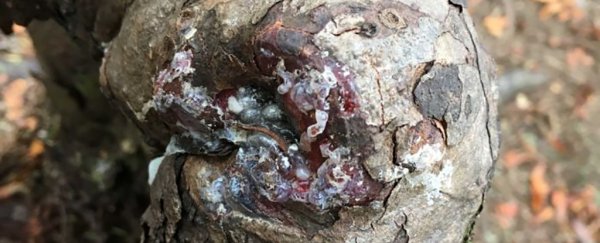Thanks to a chance observation during a woodland ramble, scientists have found evidence that trees can keep each other alive by sharing water and other resources – forming a type of 'superorganism' that works together to keep individuals alive.
In this way, a tree stump has been able to survive and cycle water, even without foliage of its own.
Ecologists Sebastian Leuzinger and Martin Bader spotted the apparently dead kauri pine tree stump (Agathis australis) in one of New Zealand's North Island forests, but it showed something that dead trees don't have: sap running through it.
By measuring water flow in the stump and the surrounding trees, the researchers found they closely matched, suggesting the kauri pine's nearest neighbours are keeping it on life support. That opens up another question – why?
"For the stump, the advantages are obvious – it would be dead without the grafts, because it doesn't have any green tissue of its own," says Leuzinger.
"But why would the green trees keep their grandpa tree alive on the forest floor while it doesn't seem to provide anything for its host trees?"
Leuzinger and his colleagues think the tree stump's roots have been grafted together with roots from other trees, something that is known to happen when trees sense they can share resources with the trees around them. These grafts allow trees to form a type of 'superorganism' in a forest, and help groups of trees improve their collective stability.
But it's rare to find this happening in dying stumps clinging to life – scientists have suspected it goes on, but previous research is decades old and inconclusive as to the underlying mechanisms. It's never been seen before in kauri trees.
Water typically gets pulled up through trees, as it evaporates from its leaves and gets replenished from the roots. That can't be happening in the stump, but water continues to flow – albeit at a slower rate than the surrounding trees.
"This is different from how normal trees operate, where the water flow is driven by the water potential of the atmosphere," says Leuzinger.
"In this case, the stump has to follow what the rest of the trees do or else use osmotic pressure to drive water flow, because since it lacks transpiring leaves, it escapes the atmospheric pull."
It's not clear yet what the surrounding trees get out of a deal like this. The researchers say one possible is that the connections were formed when the stump was still a healthy tree, and it's simply not letting go.
Maybe the surrounding trees get to extend their own root networks, and gather more water and nutrients, by keeping the connection to the stump.
More research is going to be needed to find out for sure. In the meantime, the study is evidence that trees are more interconnected than we perhaps thought – and that extends to looking after the pensioners of the tree community.
In a time of a rapidly shifting climate, research like this could be crucial in figuring out how woodlands and forests are going to adapt in the years ahead.
"This has far-reaching consequences for our perception of trees – possibly we are not really dealing with trees as individuals, but with the forest as a superorganism," says Leuzinger.
The research has been published in iScience.
